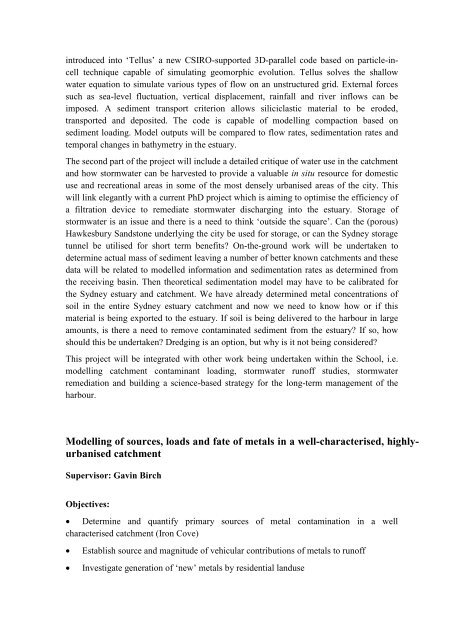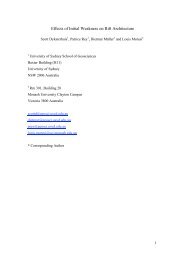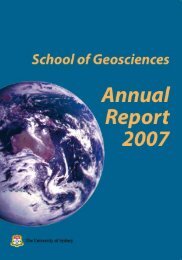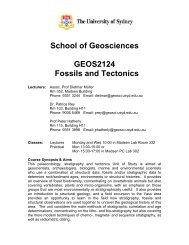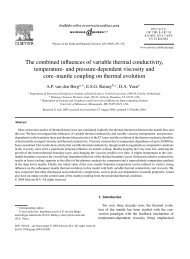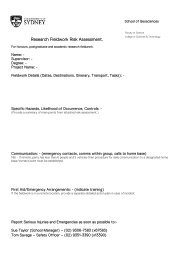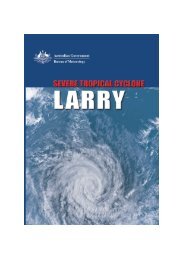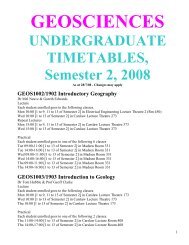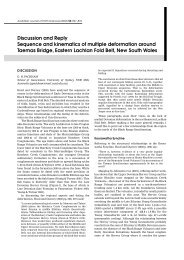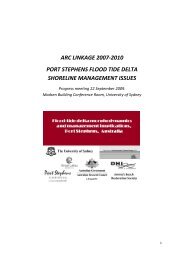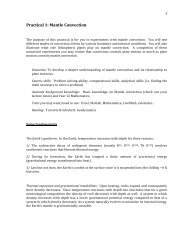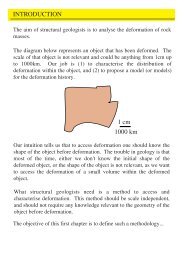Gavin Birch - School of Geosciences
Gavin Birch - School of Geosciences
Gavin Birch - School of Geosciences
You also want an ePaper? Increase the reach of your titles
YUMPU automatically turns print PDFs into web optimized ePapers that Google loves.
introduced into ‘Tellus’ a new CSIRO-supported 3D-parallel code based on particle-incell<br />
technique capable <strong>of</strong> simulating geomorphic evolution. Tellus solves the shallow<br />
water equation to simulate various types <strong>of</strong> flow on an unstructured grid. External forces<br />
such as sea-level fluctuation, vertical displacement, rainfall and river inflows can be<br />
imposed. A sediment transport criterion allows siliciclastic material to be eroded,<br />
transported and deposited. The code is capable <strong>of</strong> modelling compaction based on<br />
sediment loading. Model outputs will be compared to flow rates, sedimentation rates and<br />
temporal changes in bathymetry in the estuary.<br />
The second part <strong>of</strong> the project will include a detailed critique <strong>of</strong> water use in the catchment<br />
and how stormwater can be harvested to provide a valuable in situ resource for domestic<br />
use and recreational areas in some <strong>of</strong> the most densely urbanised areas <strong>of</strong> the city. This<br />
will link elegantly with a current PhD project which is aiming to optimise the efficiency <strong>of</strong><br />
a filtration device to remediate stormwater discharging into the estuary. Storage <strong>of</strong><br />
stormwater is an issue and there is a need to think ‘outside the square’. Can the (porous)<br />
Hawkesbury Sandstone underlying the city be used for storage, or can the Sydney storage<br />
tunnel be utilised for short term benefits? On-the-ground work will be undertaken to<br />
determine actual mass <strong>of</strong> sediment leaving a number <strong>of</strong> better known catchments and these<br />
data will be related to modelled information and sedimentation rates as determined from<br />
the receiving basin. Then theoretical sedimentation model may have to be calibrated for<br />
the Sydney estuary and catchment. We have already determined metal concentrations <strong>of</strong><br />
soil in the entire Sydney estuary catchment and now we need to know how or if this<br />
material is being exported to the estuary. If soil is being delivered to the harbour in large<br />
amounts, is there a need to remove contaminated sediment from the estuary? If so, how<br />
should this be undertaken? Dredging is an option, but why is it not being considered?<br />
This project will be integrated with other work being undertaken within the <strong>School</strong>, i.e.<br />
modelling catchment contaminant loading, stormwater run<strong>of</strong>f studies, stormwater<br />
remediation and building a science-based strategy for the long-term management <strong>of</strong> the<br />
harbour.<br />
Modelling <strong>of</strong> sources, loads and fate <strong>of</strong> metals in a well-characterised, highlyurbanised<br />
catchment<br />
Supervisor: <strong>Gavin</strong> <strong>Birch</strong><br />
Objectives:<br />
Determine and quantify primary sources <strong>of</strong> metal contamination in a well<br />
characterised catchment (Iron Cove)<br />
Establish source and magnitude <strong>of</strong> vehicular contributions <strong>of</strong> metals to run<strong>of</strong>f<br />
Investigate generation <strong>of</strong> ‘new’ metals by residential landuse


